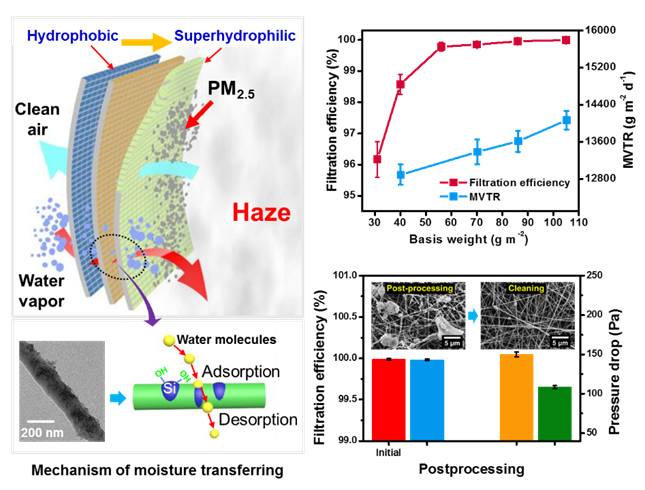Recently, the Functional Textile Material Group led by Prof. Bin Ding in our college has made a new breakthrough in the fabrication of cleanable air filtration materials possessing excellent thermal-physiological comfort.This work was published with the title of “Cleanable Air Filter Transferring Moisture and EffectivelyCapturing PM2.5” inSmall (Small 2017, 13, 1603306).
 chematic illustrationof the structure of cleanable air filter and the performance demonstration of transferring moisture and effectively capturing PM2.5.
chematic illustrationof the structure of cleanable air filter and the performance demonstration of transferring moisture and effectively capturing PM2.5.
The lethal danger of particulate matter (PM) pollution on health leads to the development of air filtration materials used for individual protection. Ideal individual protection materials (IPMs) should exhibit a high PM2.5 purification efficiency, low air resistance, an important moisture-vaportransmission rate (MVTR), and an easy-to-clean property.Currently, electret melt-blown fibrous materials present the advantage of havinga high-performance initially, but their use is impeded due to the sharp decrease of filtration efficiencyresulted from the easy dissipation of charges, low moisture-vaportransmission rate, and poor cleanable property. Recently, electrospun nanofibrous filters have gained intensive attention due to their dramatically decreased diameters, which impart them with effectively reduced pore sizes and improved porosity. Nevertheless, fabricating homogeneous, structurally stable, and cleanable IPMs capable of transferring rapidly the water vapor without compromising the filtration properties remains a great challenge yet.
Hence, the researchers prepared a cleanable air filter able to rapidly transfer moisture and efficiently capture PM2.5 by electrospinning superhydrophilic polyacrylonitrile/silicon-dioxide (PAN/SiO2) fibers as the adsorption–desorption vector for moisture-vapor, and hydrophobic polyvinylidene fluoride (PVDF) fibers as the repellent components to avoid the formation of capillary water under high humidity. The desorption rate of water molecules increased from 10 to 18 mg min−1, while the diameters of PAN fibers reduced from 1.02 to 0.14 μm. Significantly, by introducing the hydroxyl on the surface of PAN nanofibers, rapid adsorption–desorption of the water molecules was observed. Moreover, by constructing a hydrophobic to superhydrophilic gradient structure, the MVTR increased from 10346 to 14066 g m−2 d−1. More importantly, the resultant fibrous membranes presented a stable PM2.5 purification efficiency of 99.99%,a low air resistance of 86 Pa and easily cleaning property at high MVTR during haze event. The successful fabrication of such an intriguing material may provide a new approach for the design and development of air filtration materials possessing encouraging thermal-physiological comfort.
This work is supported by the Key Technologies R&D Programof China (Grant Nos. 2015BAE01B01 and 2015BAE01B02),the National Natural Science Foundation of China (Grant Nos.51273038, 51322304, and 51503030), the “DHU DistinguishedYoung Professor Program,” the Fundamental Research Funds forthe Central Universities (Grant Nos. 16D110115 and 16D310110),and the Shanghai Sailing Program (Grant No. 15YF1400600).

